

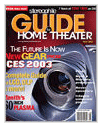 This
is a featured article by: Stereophile Guide to Home Theater,
January 1999. This
is a featured article by: Stereophile Guide to Home Theater,
January 1999. |
E·vo·lu·tion·ary
ACHIEVEMENT
Story by Maureen C. Jenson
Photography by George Heinrich
A Canadian businessman builds
the home theater of his dreams... for now

 |
|
| A contemporary
stairway descends to the 18x29-foot basement level home
theater, which was formerly a billiards room. |
|
|
"This home theatre will
never really be finished," says homeowner Mark, a Canadian
businessman who prefers to remain on a first-name-only basis.
"A system is an evolution. Our theater has changed immensely
from what it was two years ago."
What Mark and Irene's home theater
has evolved into is truly breathtaking. At the basement level
of the house is an 18x29-foot space that was previously an unused
billiards room. Over the past two years the space has undergone
a transformation to exacting specifications, and now it houses
some of the finest audio and video components made.
A contemporary stairway descends
to the 18x29-foot basement level home theater, which was formerly
a billiards room. Mark is a perfectionist, so he surrounded himself
with professionals who understood his home-theater vision and
shared his high standards. His interest was piqued when he heard
the home-theater system of Andrew Lam, a designer who specializes
in room acoustics. Lam's system has been designed by Dennis Penner
of American Hi-Fi, who was subsequently contracted to install
Mark's system.
"The three of us are a great team," Mark says. "When
I went to Andrew's home and watched a movie in his home theater,
I knew we were on the same wavelength, and I wanted him to design
my own home theater." Lam has a wealth of design experience,
including concert-hall design, and he firmly believes that even
the greatest equipment can perform at its best only in a room
that has been acoustically treated.
Enter please
As you stroll through the house
with Mark, good design is apparent everywhere. "My wife,
Irene, has a major impact on the colors and fabrics, and she did
an excellent job." As you approach the theater, you see a
glass wall and door, elements not normally associated with a room
used as a playback environment. According to Lam, "The windows
and door on the left side wall facing the screen were necessary
because Mark and Irene didn't want the theater to resemble a cave."
| |
 |
| |
| The theater's
main left and right channels are reproduced by a pair
of Wilson Audio X-1 Grand SLAMM System II loud-speakers
powered by a Krell FPB 600 stereo power amplifier. A
Martin-Logon Logos center-channel speaker is attached
to the ceiling; the Stewart StudioTek screen descends
behind it. |
|
Of course, doors and windows
can leak sound; Lam chose a three-layer concept to address the
problem. "Inside the theater, I used ¼-inch tempered
glass sealed tight against a glazing stop. If sound leaks through
the glass, it is partially absorbed by two inches of air space.
Then there is a sealed. double-pane glass panel that's a total
of ¾-inch thick, including an air space between the panes.
This three-layered concept greatly reduces the sound energy escaping
into the rest of the home. I put the thickest glass inside because
when the system is pushing a lot of air, thin glass can vibrate,
resulting in a rattling noise."
Over the glass, Lam installed
doubled-layered, retractable vertical blinds. The top layer is
a fabric material with PVC behind it. The blinds are concave and
behave like diffusers; the curved portion bounces the sound back
into the room. On the right wall facing the screen , a wedge-shaped
bass trap gives the room a more balanced tone. "Both materials
are soft, and the bass trap reduces the standing-wave problem
because it is a wedge shape."
 |
|
| The theater's
main left and right channels are reproduced by a pair
of Wilson Audio X-1 Grand SLAMM System II loud-speakers
powered by a Krell FPB 600 stereo power amplifier.
A Martin-Logon Logos center-channel speaker is attached
to the ceiling; the Stewart StudioTek screen descends
behind it. |
|
|
Let's talk system
From the moment you step inside,
you realize that this is the home theater of a serious enthusiast.
A pair of Wilson Audio X-1 Grand SLAMM System II speakers, placed
9 feet apart, flank a retractable Stewart StudioTek 130 80x45-inch
Electrimask screen. A Martin-Logan Logos center-channel speaker
is mounted on the ceiling above the screen, and Martin-Logan Stylos
speakers attached to the side and rear walls provide surround
sound. A Velodyne FSR-18 subwoofer provides additional deep-bass
response.
Krell amplifiers drive all speakers,
and the CD player is a Krell KPS-20i that incorporates a unique
dual suspension system to isolate the transport from vibration.
The Krell Audio+Video Standard surround processor/preamp includes
Dolby Digital and DTS capabilities.
When asked why he chose Krell amps, Penner doesn't hesitate: "Krell
makes the best amplifiers around in terms of speed of reaction,
resolution, and detail, yet they don't sound clinical or harsh,
like some solid-state amps do. They also have tremendous reserve
power, which is important for movie soundtracks; you have high
power demands if you're playing the system at realistic levels.
In music, you get short peaks that require large amounts of power
for a short duration, but on movies soundtracks, some of the explosions
and other sounds go on for extended periods of time. You need
large, continuous amounts of power for that.
| |
 |
| |
| The equipment
rests on shelves along the left wall. Six custom speed-controlled
fans built into the back of the shelves transfer heat
into another room. Mark's home-theater system incorporates
high-end components including a Krell Audio+Video Standard
surround processor. Krell KPS-20i CD player, Faroudja
DV-1000 DVD player and VP400A line quadrupler, EAD TheaterVision
laserdisc transport, Sony R1000 S-VHS VCR, Nakamichi
Dragon cassette deck, and Sequerra FM-1 tuner. |
|
"Krell offers tremendous
peak capability as well as lots of continuous-power capability.
One of the ways you can gauge this is to look at an amp's power
ratings into 8, 4 and 2W. Theoretically, the power rating should
double every time the impedance goes down by half. In reality,
though most amps cannot do that because their power supplies are
limited. But Krell amps, particularly the Full Powered Balanced
[FPB] series, are fully regulated from input to output. So the
amp will always respond to the demand as long as you're able to
feed it enough AC current."
The Wilson Grand SLAMM driver
array consists of a 1-inch forward-firing tweeter, two 1-inch
rear firing tweeters, two 6-inch mid-frequency drivers, a 12-inch
woofer, and a 15-inch woofer. The massive system's frequency response
is rated at 19.5 Hz - 22.5, +- 3 dB.
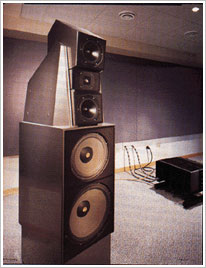 |
|
| The Wilson
Grand SLAMM driver array consists of a 1-inch forward-firing
tweeter, two 1-inch rear firing tweeters, two 6-inch
mid-frequency drivers, a 12-inch woofer, and a 15-inch
woofer. The massive system's frequency response is rated
at 19.5 Hz - 22.5, +- 3 dB. |
|
|
A Krell FPB 600 amp supplies
600 Wpc to the Grand SLAMMs. Penner doubts if they ever use all
600W, but when they went from a 15-amp circuit to a separate 30-amp
circuit just for the FPB 600, there was a noticeable improvement.
"A second 30-amp circuit was also installed for future upgrades,"
Penner continues. "The side-and-rear channel Martin-Logan
Stylos speakers are powered by two Krell KAV-250a stereo amps
that are rated at 250 Wpc into 8Wand 500 Wpc into 4W. The Stylos
is nominally rated at 6W, so there is no shortage of power here."
During one of the theater's recent upgrades, the Krell KAV-250a
amp that had been powering the Martin-Logan Logos center-channel
speaker was replaced by an FPB 250M. Even though it has the same
power rating as the KAV-250a, the FPB 250M is a superior amplifier
in the Full Powered Balanced series. "I've heard plenty of
audiophiles say that the vacuum-tube equipment is more liquid
and true to the music," Mark says, "but I disagree.
You just can't beat a good solid state amplifier; it's more accurate
and therefore more realistic."
To analyze the home theaters
he designs, Penner uses a Goldline real-time analyzer connected
to his computer, which offers measuring bands as fine as 1/12
octave from 800Hz down and 1/3 octave full-range. But an analysis
of the theater is just a starting point. "The final, acid
test is always in the listening," Penner says, "In Mark's
system, there are no equalizers to change it. All we can do with
his system is reposition the speakers. The Grand SLAMMs are actually
in a fixed location and were tuned by Matt Tucker from Wilson
Audio. They are in the ideal spot."
All the people involved in the
design of this theater are enthusiastic proponents of high-end
cable, and Straight Wire products were used throughout the system.
According to Mark, there was a discernible difference in the sound
quality after the cable had "burned in" over an extended
listening period. (At the time of construction, 2-inch plastic
conduit was used for all cable runs to allow for future additions
and upgrades.) The video side of the system is just as impressive
as its audio counterpart. A ceiling mounted Vidikron VPF-50HD
video projector fires onto a Stewart StudioTek 130 screen from
a distance of 12 ½ feet. The Vidikron is coupled with a
Faroudja VP400A line quadrupler to provide film like quality.
Source components such as Faroudja DV-1000 DVD transport, Enlightened
Audio Designs (EAD) Theater Vision laserdisc transport, and Sony
R1000 S-VHS VCR provide Mark with the best video reproduction
money can buy.
| |
 |
| |
| The right
wall of the theater supports a wedge-shaped bass trap.
The ceiling features a curved treatment that offers
both adsorption and diffusion similar to many professional
concert halls. |
|
"I have an outstanding
array of components," Mark says with pride, "but if
I had placed them in our living room, they would not have sounded
as superb as they do in our home theater. What you do to improve
the sound of a room acoustically is just an important as what
you do electronically."
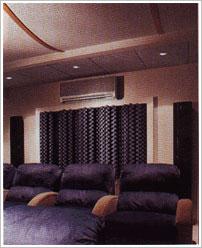 |
|
| A pair of
Martin-Logan Stylos electrostatic speaker reproduce
rear-channel sound. Between them is a whisper-quiet
Sanyo split-system air-conditioner over an 8-foot-long
ART diffuser. |
|
|
From basement to theater
The entry point of the theater--with
its glass wall and door--could have been problematic. "Because
the home theater was going to be in an existing basement space,
we had lots of restrictions from the onset," Lam says.
"However, with the computer
programs available today, there is no reason why any home theater
cannot be designed with mathematical accuracy. In particular,
I never want any two dimensions of the room to be equal, which
can cause acoustical problems. “Supervision of the contracting
team is also very important. When I’m building a home theater,
I’m on the job site at least twice a day. I just can’t
design a good theater and walk away from it hoping that my design
specifications will be followed. I have to be diligent.
For Mark’s theater, I
designed a sound-controlled room, not a room that is 100% soundproof.
The sound transmission to other rooms is very low, even if we
turn up the system to 99dB. The sound doesn’t leak through
the walls or ceiling. Above the theater is the living room, so
sound leakage could not be permitted. Lam had to design an attenuation-diffuser
system in the ceiling not only to prevent sound leakage, but to
provide more open sound. (The height from floor to ceiling is
9 feet.)
| |
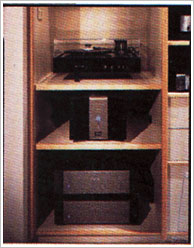 |
| |
| Shown here
are the system's Goldmund Studio turntable. Krell FPB
250M monoblock amp (which powers the Martin-Logan Logos
center-channel speaker), and two Krell KAV-205a stereo
power amps (which drive the side and rear channel Martin-Logan
Stylos speaker). |
|
“As in many fine concert
halls, I used a curved treatment that provides good sound diffusion
and absorption. The finish is a special paint called Polomyx,
which has thousands of tiny holes. Behind that is 4 inches of
sound-absorbing insulation, then air space, aluminum sheeting,
and another 8 inches of insulation. The metal sheeting is necessary
because it is a very dense material, and it separates the floor
joists for the from the insulation, which isolates sound transmission
to the home theater.”
Because the theater was constructed
within what had once been the basement, the walls were concrete.
As a result, the front third of the room was treated with 3-inch-thick,
fabric-covered Fiberglas absorptive panels, locally manufactured
by Sound Concepts. As you face the screen, the right wall has
three Acoustic Wedge bass traps by Systems Design Group (SDG)
that weak measure 46 inches in length.
The rear wall is treated with
ART Diffusors, which are also manufactured by SDG. These diffusers
protrude 9 inches from the wall and are made of rigid 15x15-inch
polyurethane panels. The nearly 8-foot-long diffuser takes up
very little space, yet it distributes sound evenly throughout
the theater.
“I tuned the room as neutral
as possible so the wall reflections could not color the sound,”
Lam says. “I basically eliminated the room’s parallel
surfaces, minimizing the standing-wave problem. The walls and
ceiling fan out from the front of the room to the back; the ceiling
gas a 3-degree upward incline like a concert hall. This helps
make the sound open and transparent”.
Heating
up
One of the main problems in
a dedicated home theater is often the ventilation. When you have
a projector, several amplifiers, and a few people drinking and
chatting, it takes only a few minutes for a home theater to heat
up unbearable, and heat could have been a major problem in this
room. Lam used a “split-system” air conditioner by
Sanyo on the rear wall just above the diffuser. (In a split-system
air-conditioner, the compressor and fan are separate, which allows
them to be placed in separate locations to minimize noise.)
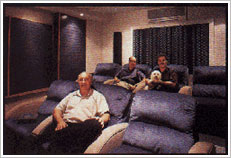 |
|
| Reveling in
Mark's home theater are Dennis Penner of American Hi-Fi
(seated in front row), Designer Andrew Lam, and homeowner
Mark (holding the dog, Winston). |
|
|
“This unit is highly recommended
for any application where extraneous noise would be a problem,
because the compressor is mounted externally. It cools the room
very quickly. and I have seen it used in many hi-fi stores in
Hong Kong. Keeping the room comfortable is not only for the guests;
it also helps keep the equipment working at peak performance.
Lam provided another cooling
system behind the main shelves of components. Six 4-inch silent
fans were installed behind the equipment rack to exhaust heated
air from the equipment into another room. “My design is
not like some you see, where you but and equipment rack, close
it off, and put a fan in it. In addition to the fans behind the
equipment rack, I also installed two ceiling fans over the main
Krell 600 amp at the front of the theater; they pull the heat
upward and out of the room, And all the ductwork in the theater
had to be treated with particular care every inch had to be acoustically
insulated. If you gave any frequency going into a metal duct,
it’s going to ring like a bell.”
| |
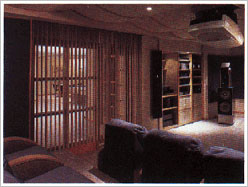 |
| |
| Designer Lam
had a doubled-layered retractable vertical blinds installed
over the glass windows and door on the left side of
the theater. The curved blinds are said to behave like
diffusers. |
|
Penner designed a unique speed
control for the fans. A microphone monitors the sound level in
the room; as the sound level increases, an automatic gain circuit
increases the voltage to the fans, making them rotate faster.
With all these fans in motion, you might wonder whether they add
extraneous noise to the space.
“The NC [Noise Criterion] level of the theater is 38 dB
to 40 dB, which means it is very quit,” says Lam. “Additional
ventilation was needed because the moisture coming up from the
concrete slab. If wood sits directly on the slab, it will eventually
rot. So there are 2-inches of cross-ventilation space between
the slab and flooring for that crucial air movement.
“The
rise that gold the second tier of seating is insulated, like all
the enclosed air spaces in the room. If we hadn’t insulated
the rise, you would have heard a rumbling sound any time anyone
walked on it. The riser is constructed of 2x6-inch framing and
tongue-and-grove plywood, and it’s anchored to the concrete
floor with glue and wood-based screws—again, to have as
little sound as possible hitting a surface that would produce
a ringing effect. Under the nosing of the riser step is a 15-foot,
8-inch continuous strip of low-voltage lighting to assist guests
moving about in the darkened theater.”
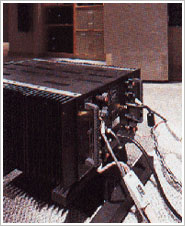 |
|
| A firm believer
in premium wire and cable, the homeowner used Straight
Wire and MIT cables throughout the home theater. Straight
Wire Cresendo interconnects are paired with the KRell
FPB 600 amp to power the Grand SLAMMs |
|
|
Dedicated theater seating was
selected after Mark and Irene saw Acoustic Innovations recliners
with built-in cup-holders. The seven incredibly comfortable seats
are offset from each other to eliminate sightline obstructions.
(The front row of chairs is 14-feet from the screen.) “In
a good concert hall, they cover every chair with a sound-absorbing
material. If a chair is empty, that seat must react with the theater
as if a sound-absorbing body was sitting in it,” Lam says.
Serious consideration was also
given to the carpeting for the theater. Lam chose a very-high-density
material that actually incorporates static control. “In
Canada, we have to use a lot of heat, and the house gets very
dry, so when you touch the equipment, there’s a spark problem.
The fir in the carpet itself has a grounding system; each loop
of carpet contains a grounding fiber. It helps eliminate friction,
giving you minimum static, which is perfect for colder climates.”
Whether it’s cold or warm
in their Canadian homeland, Mark and Irene derive tremendous pleasure
from their home theater, enjoying everything from film classics
such as Some Like it Hot to Elton John concert performances. When
it’s time for music only, their eclectic tastes range from
symphonies to rock ‘n roll. “A symphony really shows
off what the system can do,” Mark says. “A symphony
really runs the gamut.”
Their love of music and movies
is not eclipsed by the home theater’s work-oriented duties.
“I follow the stock market very closely,” says Mark.
“With the Vidikron VPF-50HD projector, I can use my computer
if I want to work down in the theater and see my spreadsheets
on the screen. But it’s even more pun to watch CNBC to see
how the markets are fluctuating on the floor of the New York Stock
Exchange. There’s nothing more exciting than watching the
real life drama of fortunes being made and lost on an 80-inch
screen.”
|

















